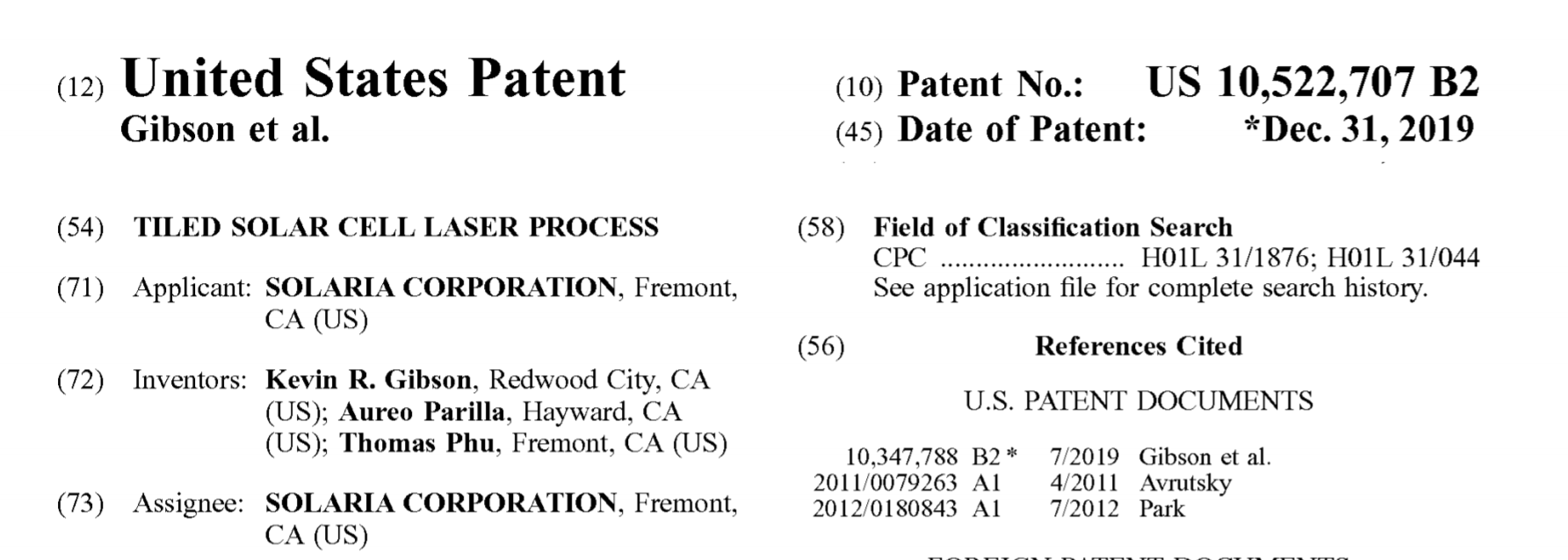Philosophically, we could go long: “Humanity exists as it does because we learned to use fire, the original self-generated distributed energy technology, and then we shared it across the whole of the species. Solar power is a modern version of fire, and we must expect that the knowledge of this new technology will tend to spread.”- CommercialSolarGuy.
Or we could go short: “Imitation is the sincerest form of flattery.” – Oscar Wilde.

Solaria SPI 2019 on left vs Canadian Solar HiDM on right
Solaria Corporation v. Canadian Solar
On March 31 2020, the Solaria Corporation filed a lawsuit against Canadian Solar Inc – case number 3:2020cv02169 – in the California Northern District Court. Solaria contends that Canadian Solar infringes on a U.S. patent that “covers a process for separating photovoltaic (PV) strips from solar cells for use in a tiled or so-called ‘shingled’ solar module.”
Solaria says the shingled solar cells are made in machines manufactured by Suzhou Autoway System Co., Ltd.
In 2014 and 2015, Solaria and Canadian Solar conferred about a potential licensing deal of Solaria technology. This included Solaria site tours and technology presentations. The interaction ended without a deal as Canadian Solar declined having interest.
Solaria submitted as “Exhibit A” U.S. Patent 10,522,707.
Solaria says Canadian Solar began selling its High Density Shingle Mono Perc-Modules (HiDM) in the U.S. last year, and wishes for the product to be withdrawn from the market. Solaria notes that it has it’s own PowerXT® High Density Module (HDM) shingled module product.
Solaria purchased a Canadian Solar HiDM, disassembled it, and then took a scanning electron microscope to it. This image is taken at the overlap (shingled) region of two PV monocrystalline cell strips (a top cell and a bottom cell).
The specific violations of the patent that Solaria noted were that the Canadian Solar module is:
- Using monocrystalline solar cells which have a backside containing a metal material, a front side, and a thickness;
- Placing the front side of the solar cells on a surface such that the backside is facing a laser source;
- Initiating a laser to output a laser beam;
- Subjecting a portion of the backside to the laser beam to cause an ablation to form a scribe region which has a depth, width, and a length, the depth being approximately 50% of the thickness of the solar cell and the length being equivalent to a length of the solar cell;
- Removing the vaporized material from the vicinity of the ablation; [f] capturing the vaporized material using a vacuum; and
- The laser source comprises an infrared (IR) laser.
This product, and Solaria, have been in legal moments prior. In 2017, GCL Poly-Energy reportedly settled a complaint for the “abuse of business secrets concerning shingled array technology used to assemble crystalline silicon solar modules.” The articles noted that Solaria also sued China-based Jiangsu Seraphim Solar System and PV equipment maker Suzhou Autoway System for the same reason.
Other companies are now offering up shingled type products. LONGi launched their product into Australia. SunPower’s P-Series is available for commercial projects in the United States. The panels are assembled in Oregon, with cells probably manufactured as part of a 2017 agreement.
Solar cell size is evolving, which changes the number of cells in a solar module – the new trend toward “large wafers” is shown in Trina’s first 500 watt solar module. The company uses a 210 millimeter solar cell – larger than the industry stalwart around 155 mm.
Do also note that Trina experimented with this module but cutting the cells up into smaller pieces to modify the module’s electrical properties. Solaria’s goal of cutting cells up was the increase the number of solar cells a module could fit, similar to the new increase in cell size to 210 mm.
Interested in installing residential solar power?
If you’re considering installing residential solar power, the Solaria product is great. I’ve written about it for many years. Below is an installation CommercialSolarGuy participated in at the end of 2019 in Westport, Massachusetts.
If you’re interested in a residential solar and energy storage quote, and you’re nearby New Bedford, Massachusetts – give us a call at 508-499-9SUN (786) or contact us here.

Solaria Solar Modules – Westport, Massachusetts

